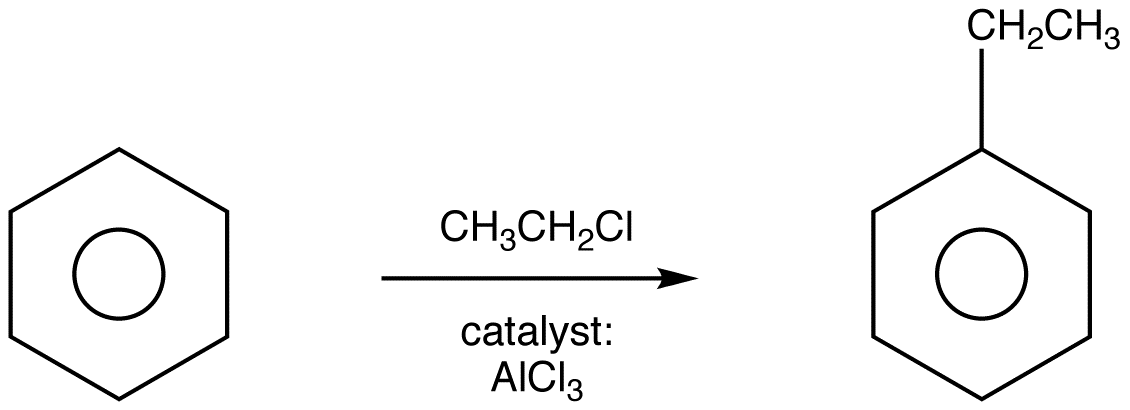18.5: Alkylation and Acylation of Benzene - The Friedel-Crafts EAS Reactions
- Page ID
- 45578
Friedel-Crafts Alkylation
The Fridedel-Crafts Alkylation reaction froms alkyl benzenes from alkyl halides. The usefulness of this reaction is limited, because it can be difficult to stop the reaction at a single alkylation. Additionally, a carbocation intermediate is produced in Step 1 which brings the potential for carbocation rearrangements (ominous theme music).

The mechanism takes place as follows:
Step 1: A carbocation is created to form the electrophile. This steps activates the haloalkane. Secondary and tertiary halides only form the free carbocation in this step.
.png?revision=1)
Step 2: The pi electrons from benzene react with the electrophile to form the resonance stabilized alkylbenzenium ion.

Step 3: Any Lewis Base reacts picks up the hydrogen from the allkylbenzenium ion to reform the aromatic ring.

The finish step shown above is the two products.
The reactivity of haloalkanes increases as you move up the periodic table and increase polarity. This means that an RF haloalkane is most reactive followed by RCl then RBr and finally RI. This means that the Lewis acids used as catalysts in Friedel-Crafts Alkylation reactions tend have similar halogen combinations such as BF3, SbCl5, AlCl3, SbCl5, and AlBr3, all of which are commonly used in these reactions.
Some limitations of Friedel-Crafts Alkylation
There are possibilities of carbocation rearrangements when you are trying to add a carbon chain greater than two carbons. The rearrangements occur due to hydride shifts and methyl shifts. For example, the product of a Friedel-Crafts Alkylation will show an iso rearrangement when adding a three carbon chain as a substituent. One way to resolve these problems is through Friedel-Crafts Acylation.
Also, the reaction will only work if the ring you are adding a substituent to is not deactivated. Friedel-Crafts fails when used with compounds such as nitrobenzene and other strong deactivating systems.
Friedel-Crafts reactions cannot be preformed then the aromatic ring contains a NH2, NHR, or NR2 substituent. The lone pair electrons on the amines react with the Lewis acid AlCl3. This places a positive charge next to the benzene ring, which is so strongly activating that the Friedel-Crafts reaction cannot occur.
Lastly, Friedel-Crafts alkylation can undergo polyalkylation. The reaction adds an electron donating alkyl group, which activates the benzene ring to further alkylation.
This problem does not occur during Friedel-Crafts Acylation because an acyl group is deactivating. The prevents further acylations.
Friedel-Crafts Acylation
There is an additional reaction step for Fridel-Crafts Acylation. The acyl group of the product complexes with the aluminum chloride. Water is added to isolate the acyl benzene final product.

1st Reaction
Mechanism Step 1: Acylium ion formation
Mechanism Step 2: Pi electrons of benzene react with the acylium ion to form the sigma complex, resonance stabilized acylbenzenium intermediate:
.jpg?revision=1)
Mechanism Step 3: Deprotonation of the sigma comlex to restore aromaticity.
During the third step, AlCl4 returns to remove a proton from the benzene ring, which enables the ring to return to aromaticity. In doing so, the original AlCl3 is regenerated for use again, along with HCl. Most importantly, we have the first part of the final product of the reaction, which is a ketone. The product forms a complex with aluminum chloride as shown below.
.jpg?revision=1)
2nd Reaction: Water is added to liberate the final product as the acylbenzene:
.jpg?revision=1)
Friedel-Crafts Acylations offer several synthetic advantages over Friedel-Crafts Alkylation. These advantages provide greater control over the production of reaction products. The acylium ion is stabilized by resonance, so no carbocation rearrangement occurs. Additionally, acyl groups are deactivating with for EAS reactions, so the product does not undergo further reactions. However, Friedel-Crafts Acylations do not work with nitrobenzenes or other deactivated benzene rings. The concept of deactivated will be more fully explored in the next two sections of this chapter.
Exercise
11. Which of the following will NOT undergo a rearrangement in a Friedel-Crafts reaction?
12. Suggest an acyl chloride that was used to make the following compounds:
- Answer
-
11. A, B, and E will not undergo a rearrangement.
12.
Contributors and Attributions
Dr. Dietmar Kennepohl FCIC (Professor of Chemistry, Athabasca University)
Prof. Steven Farmer (Sonoma State University)
William Reusch, Professor Emeritus (Michigan State U.), Virtual Textbook of Organic Chemistry


.jpg?revision=1&size=bestfit&width=720&height=114)
.jpg?revision=1)